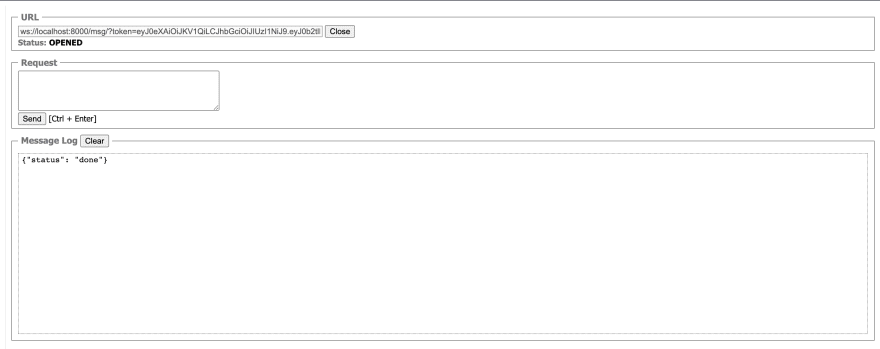In this article we will build an application which uses JWT Authentication that communicates to websocket with Django REST Framework. The main focus of this article is send data to websocket from out of consumer.
Before we start you can find the source code here
We have two requests to same endpoint GET and POST, whenever a request comes to endpoint we will send messages to websocket.
This is our models.py, our Message model looks like down below which is very simple.
from django.db import models
from django.contrib.auth import get_user_model
User = get_user_model()
class Message(models.Model):
message = models.JSONField()
user = models.ForeignKey(to=User, on_delete=models.CASCADE, null=True, blank=True)
Configurations
We need a routing.py file which includes url's of related app.
from django.urls import re_path
from . import consumers
websocket_urlpatterns = [
re_path(r'msg/', consumers.ChatConsumer.as_asgi()),
]
Then we need another routing.py file into project's core directory.
import os
from websocket.middlewares import WebSocketJWTAuthMiddleware
from channels.routing import ProtocolTypeRouter, URLRouter
from django.core.asgi import get_asgi_application
from websocket import routing
os.environ.setdefault("DJANGO_SETTINGS_MODULE", "django_ws.settings")
application = ProtocolTypeRouter(
{
"http": get_asgi_application(),
"websocket": WebSocketJWTAuthMiddleware(URLRouter(routing.websocket_urlpatterns)),
}
)
As you can see here a middleware is used, what this middleware does is control the authentication process, if you follow this link you will see that Django has support for standard Django authentication, since we are using JWT Authentication a custom middleware is needed. In this project Rest Framework SimpleJWT was used, when create a connection we are sending token with a query-string which is NOT so secure. We assigned user to scope as down below. middlewares.py
from urllib.parse import parse_qs
from channels.db import database_sync_to_async
from django.contrib.auth import get_user_model
from django.contrib.auth.models import AnonymousUser
from rest_framework_simplejwt.tokens import AccessToken, TokenError
User = get_user_model()
@database_sync_to_async
def get_user(user_id):
try:
return User.objects.get(id=user_id)
except User.DoesNotExist:
return AnonymousUser()
class WebSocketJWTAuthMiddleware:
def __init__(self, app):
self.app = app
async def __call__(self, scope, receive, send):
parsed_query_string = parse_qs(scope["query_string"])
token = parsed_query_string.get(b"token")[0].decode("utf-8")
try:
access_token = AccessToken(token)
scope["user"] = await get_user(access_token["user_id"])
except TokenError:
scope["user"] = AnonymousUser()
return await self.app(scope, receive, send)
Last but not least settings.py file, we are using Redis as channel layer therefore we need to start a Redis server, we can do that with docker
docker run -p 6379:6379 -d redis:5
settings.py
ASGI_APPLICATION = 'django_ws.routing.application'
CHANNEL_LAYERS = {
"default": {
"BACKEND": "channels_redis.core.RedisChannelLayer",
"CONFIG": {
"hosts": [('0.0.0.0', 6379)],
},
},
}
Consumers
Here is our consumer.py file, since ChatConsumer is asynchronous when a database access is needed, related method needs a database_sync_to_async decorator.
websocket/consumer.py
import json
from channels.db import database_sync_to_async
from channels.generic.websocket import AsyncWebsocketConsumer
from django.contrib.auth.models import AnonymousUser
from websocket.models import Message
class ChatConsumer(AsyncWebsocketConsumer):
groups = ["general"]
async def connect(self):
await self.accept()
if self.scope["user"] is not AnonymousUser:
self.user_id = self.scope["user"].id
await self.channel_layer.group_add(f"{self.user_id}-message", self.channel_name)
async def send_info_to_user_group(self, event):
message = event["text"]
await self.send(text_data=json.dumps(message))
async def send_last_message(self, event):
last_msg = await self.get_last_message(self.user_id)
last_msg["status"] = event["text"]
await self.send(text_data=json.dumps(last_msg))
@database_sync_to_async
def get_last_message(self, user_id):
message = Message.objects.filter(user_id=user_id).last()
return message.message
Views
As I mentioned at previous step our consumer is asynchronous we need to convert methods from async to sync just like the name of the function
views.py
from asgiref.sync import async_to_sync
from channels.layers import get_channel_layer
from rest_framework import status
from rest_framework.permissions import IsAuthenticated
from rest_framework.response import Response
from rest_framework.views import APIView
from .models import Message
class MessageSendAPIView(APIView):
permission_classes = (IsAuthenticated,)
def get(self, request):
channel_layer = get_channel_layer()
async_to_sync(channel_layer.group_send)(
"general", {"type": "send_info_to_user_group",
"text": {"status": "done"}}
)
return Response({"status": True}, status=status.HTTP_200_OK)
def post(self, request):
msg = Message.objects.create(user=request.user, message={
"message": request.data["message"]})
socket_message = f"Message with id {msg.id} was created!"
channel_layer = get_channel_layer()
async_to_sync(channel_layer.group_send)(
f"{request.user.id}-message", {"type": "send_last_message",
"text": socket_message}
)
return Response({"status": True}, status=status.HTTP_201_CREATED)
In this view's GET request we are sending message to channel's "general" group so everyone on this group will receive that message, if you check the consumers.py you will see that our default group is "general", on the other hand in POST request we are sending our message to a specified group in an other saying, this message is only sent to a group with related user's id which means only this user receives the message.
Up to this point everything seems fine but we can't find out if it actually works fine until we try, so let's do it. I am using a Chrome extension to connect websocket.
Result of GET request

POST request

NOTE: Python3.10.0 have compatibility issue with asyncio be sure not using this version.






 已为社区贡献126446条内容
已为社区贡献126446条内容

所有评论(0)